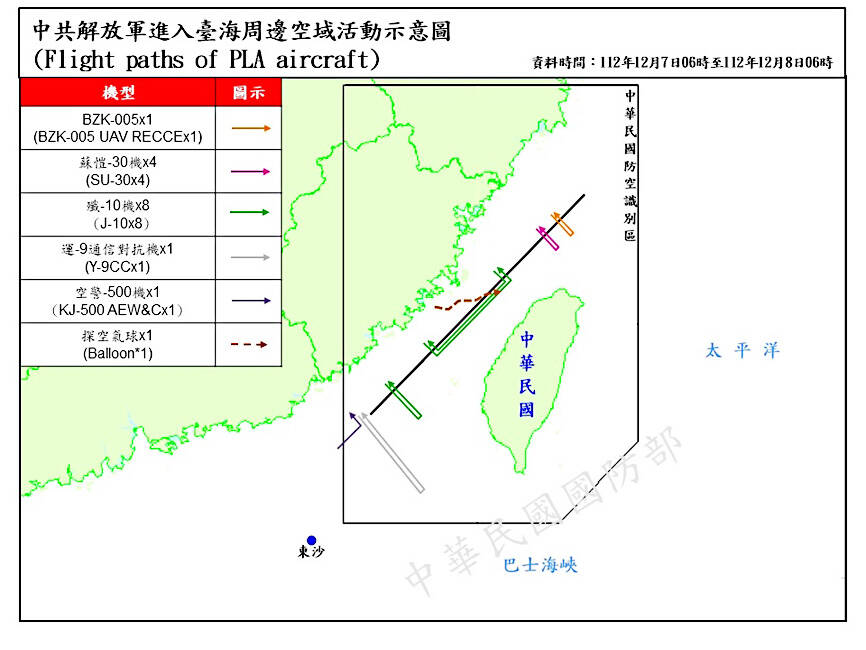The Ministry of National Defense (MND) yesterday said it had detected a Chinese balloon crossing the median line of the Taiwan Strait.
The balloon was detected at 11:52am on Thursday after crossing the median line of the Taiwan Strait 101 nautical miles (187km) southwest of Keelung, the ministry said on X, formerly known as Twitter.
The balloon floated east at an altitude of about 6,400m and disappeared at 12:55pm, it added.

Photo courtesy of the Ministry of National Defense
The ministry included a graphic showing the balloon on a meandering path.
MYSTERY
“Our preliminary understanding is that it might be a sounding or a weather balloon that drifted toward Taiwan due to monsoon winds,” Minister of National Defense Chiu Kuo-cheng (邱國正) told reporters.
Such a balloon could be used for gathering meteorological research data, such as the impact of wind forces, he added.
In Beijing, the Chinese Ministry of National Defense offered no comment, while Chinese Ministry of Foreign Affairs spokesman Wang Wenbin (汪文斌) said: “I’m not aware of the situation, and it is not a diplomatic question.”
On Thursday, the MND reported that it had detected seven Chinese aircraft crossing the median line at 7:30pm.
“The aircraft also conducted a joint combat patrol with [Chinese] vessels,” it said, adding that it had monitored and tasked “land-based missile systems to respond.”
A morning report yesterday said the ministry detected 26 planes in a 24-hour window ending at 6am, 15 of which crossed the median line or entered the southwestern and southeastern parts of the air defense identification zone.
While Beijing sends warplanes and vessels around Taiwan on a near-daily basis, nighttime activity by Chinese aircraft and the appearance of a balloon are rare.
COULD BE A TEST
Institute for National Defense and Security Research defense analyst Su Tzu-yun (蘇紫雲) said there have been instances of small Chinese weather balloons floating above Taiwan proper and outlying areas, which “do not pose a military threat.”
However, Thursday’s balloon “could be a deliberate test,” Su said.
“Besides meteorological purposes, it could also be a deliberate test conducted by the [Chinese] Eastern Theater Command or a political signal,” he said, adding that they could be a form of “political harassment.”
In February, a Chinese spy balloon that flew across the US was shot down by a US fighter jet, causing a diplomatic furor.
The huge balloon, which carried a large payload of electronics, flew over sensitive US military installations and prompted concerns Beijing was scooping up vital intelligence.
A US official said at the time the balloon had multiple antennas, including an array likely capable of collecting and geolocating communications.
China denied that the balloon was to collect intelligence and said it had strayed off course in entering US airspace.
The Pentagon concluded in June that the balloon did not gather data.
Additional reporting by AP

‘CHARM OFFENSIVE’: Beijing has been sending senior Chinese officials to Okinawa as part of efforts to influence public opinion against the US, the ‘Telegraph’ reported Beijing is believed to be sowing divisions in Japan’s Okinawa Prefecture to better facilitate an invasion of Taiwan, British newspaper the Telegraph reported on Saturday. Less than 750km from Taiwan, Okinawa hosts nearly 30,000 US troops who would likely “play a pivotal role should Beijing order the invasion of Taiwan,” it wrote. To prevent US intervention in an invasion, China is carrying out a “silent invasion” of Okinawa by stoking the flames of discontent among locals toward the US presence in the prefecture, it said. Beijing is also allegedly funding separatists in the region, including Chosuke Yara, the head of the Ryukyu Independence

UNITED: The premier said Trump’s tariff comments provided a great opportunity for the private and public sectors to come together to maintain the nation’s chip advantage The government is considering ways to assist the nation’s semiconductor industry or hosting collaborative projects with the private sector after US President Donald Trump threatened to impose a 100 percent tariff on chips exported to the US, Premier Cho Jung-tai (卓榮泰) said yesterday. Trump on Monday told Republican members of the US Congress about plans to impose sweeping tariffs on semiconductors, steel, aluminum, copper and pharmaceuticals “in the very near future.” “It’s time for the United States to return to the system that made us richer and more powerful than ever before,” Trump said at the Republican Issues Conference in Miami, Florida. “They

GOLDEN OPPORTUNITY: Taiwan must capitalize on the shock waves DeepSeek has sent through US markets to show it is a tech partner of Washington, a researcher said China’s reported breakthrough in artificial intelligence (AI) would prompt the US to seek a stronger alliance with Taiwan and Japan to secure its technological superiority, a Taiwanese researcher said yesterday. The launch of low-cost AI model DeepSeek (深度求索) on Monday sent US tech stocks tumbling, with chipmaker Nvidia Corp losing 16 percent of its value and the NASDAQ falling 612.46 points, or 3.07 percent, to close at 19,341.84 points. On the same day, the Philadelphia Stock Exchange Semiconductor Sector index dropped 488.7 points, or 9.15 percent, to close at 4,853.24 points. The launch of the Chinese chatbot proves that a competitor can

‘VERY SHALLOW’: The center of Saturday’s quake in Tainan’s Dongshan District hit at a depth of 7.7km, while yesterday’s in Nansai was at a depth of 8.1km, the CWA said Two magnitude 5.7 earthquakes that struck on Saturday night and yesterday morning were aftershocks triggered by a magnitude 6.4 quake on Tuesday last week, a seismologist said, adding that the epicenters of the aftershocks are moving westward. Saturday and yesterday’s earthquakes occurred as people were preparing for the Lunar New Year holiday this week. As of 10am yesterday, the Central Weather Administration (CWA) recorded 110 aftershocks from last week’s main earthquake, including six magnitude 5 to 6 quakes and 32 magnitude 4 to 5 tremors. Seventy-one of the earthquakes were smaller than magnitude 4. Thirty-one of the aftershocks were felt nationwide, while 79